What makes the best Garden Beds?
There are many ways to make garden beds. In this article I look at some of the materials for making the best garden beds. What type of bed you choose for growing will be determined by what you want to grow, the style of garden you choose and to some extent, your budget.
On the ground, no sides
These are basic, flat beds created straight in the ground. You can leave annual weeds on the ground, flatten them a bit with your feet or use a hoe to sever the growing tops from the roots. Cut back any pernicious weeds and remove the roots of as many as you are able. The simplest way to make a growing bed in the ground is to use the no dig method.
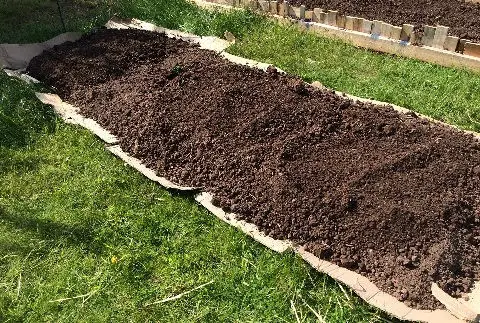
Make a basic growing bed
- Place several layers of cardboard on the ground where the bed is to be, make sure that there is no sticky tape on the cardboard as it will stay in the ground for years to come.
- Water the cardboard thoroughly until it is completely saturated through all the layers.
- Cover with around 10 – 15cms (4 – 6 ins) of compost or a mix of compost and top soil.
- Sow seeds or plant direct into the compost.
The cardboard will break down over time, but while it does, it will suppress the weeds and give the plants time to establish themselves.
Wood framed garden beds
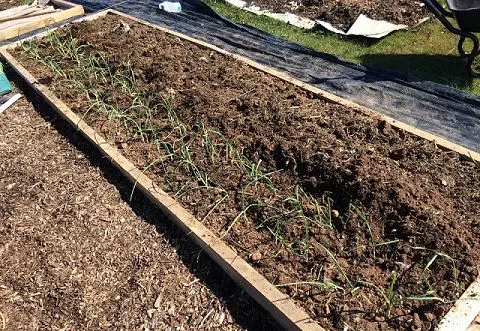
Using wood to surround a growing bed gives it definition and allows the compost to be a little deeper than an in-ground bed. We used recycled 2 x 4 inch lengths of wood to create numerous garden beds in our last home. They were effective, attractive and easy to add another layer of wood on top when we wanted to create a deeper bed.
Instant shallow raised beds
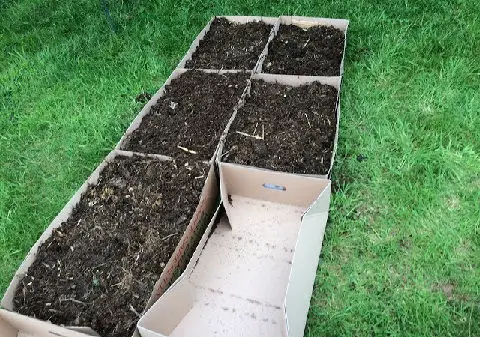
Shallow cardboard boxes can by laid side by side and filled with compost in which to grow your plants. We found that weeds grew up in the minute spaces between the boxes, so we placed a layer of card on the ground in a grid design to block weeds from growing in those gaps.
Pallet collars
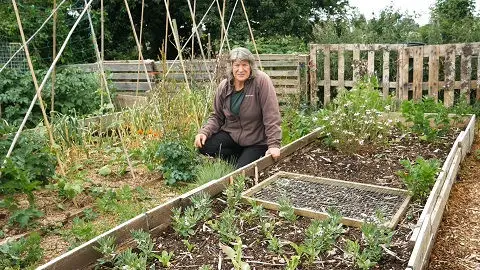
Pallet collars are a relatively economical way to create raised beds and the recycling of waste products is good practice. They can often be found given away or for a small charge from local small business or light industrial units.
We found a local company that has products delivered to it on pallets and in pallet collars. And they were very happy to sell to us, a waste product that they would otherwise have to dispose of.
Wood planks and scaffolding boards
What makes a plank a plank? Traditionally a plank of wood is at least 23cm (9 ins) wide and I think they make an ideal height for a shallow raised bed. Likewise, scaffolding boards (also known as scaffolding planks) are ideal for using to make the sides of a raised bed.
Cut to the desired length and screwed together at the corners, once filled they offer a good depth of soil. A long bed may also require some cross braces to prevent the weight of the soil pushing out the sides and making the straight edges bow.
Sleepers
Sleepers can be purchased for use in the garden. Heat treated sleepers will not damage the soil life or plants in your garden. Recycled sleepers from railway lines are likely to have undesirable chemicals on them and should be avoided.
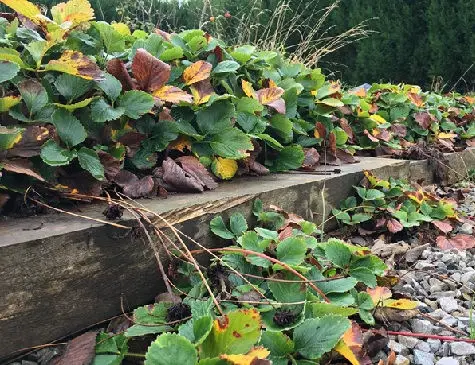
The simplest method of using sleepers is to lay them flat on the ground in the desired shape. To create deeper beds, bolt sleepers together with the shorter side on the ground. Also, they can also be stacked to create much deeper raised beds if desired.
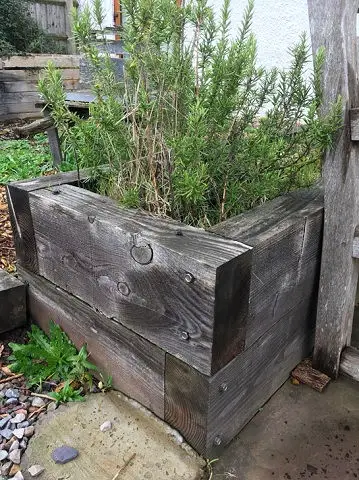
Hugelkultur beds
You can also create a deep bed using the hugelkultur method. This involves creating a mound, often semi-sunken into the ground, using tree trunks on the base layer with increasingly smaller trunks, branches, stems and twigs on top. Each layer is filled with compost, wood chips and other organic matter. The whole mound is topped with a layer of compost in which to plant. The wood absorbs water and holds it at the lower levels of the bed. The wood breaks down over a number of year providing nutrients to the soil and subsequently to the plants.

We made a deep bed using long pallets. We placed large logs in the base of it, covering them with soil, wood chips and leaves. The next layer was created smaller logs and branches, followed by twigs, wood chips and leaves. Finally, a good layer of topsoil and compost was added in which to grow the plants. You can see the videos of how we made this raised bed here.
Articles on this site may contain affiliate links. As an Amazon Affiliate, we earn from qualifying purchases. Find our full Disclosure Policy here.
Pre-made containers for garden beds
Bought-in containers range in size from a tea cup to large metal raised bed and everything in between. The best garden beds will have adequate drainage holes so that excess water can drain away and prevent your plants from rotting or drowning.
A VegTrug has legs to raise it from the ground, giving easier access, while metal raised beds are available in a variety of sizes and colours.
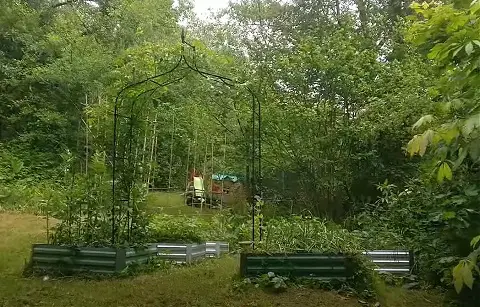
Buckets and pots
Container growing comes into its own when
- space for growing in the ground is limited,
- a particular soil type is required, like ericaceous compost for acid loving plants,
- you want to control the feeding and watering of a particular crop e.g. growing potatoes in containers,
- you want the flexibility of being able to move your plants around, perhaps to overwinter them in a greenhouse.
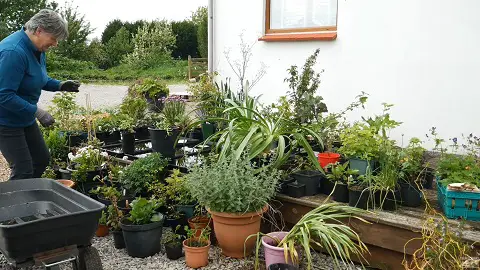
Plastic pots
On the whole, I find plastic pots and buckets pretty ugly, but they do a job. Recently, there has been a big push to reduce the amount of plastic used in our homes and gardens. I fully support the elimination of single use plastics. I struggle however, with finding an affordable alternative to plastic large plant pots. Over the years I have acquired a few large terracotta clay pots, but not nearly as many as I would need for my gardening efforts each year. I console myself with the knowledge that I reuse those large plastic pots for many years. And hopefully it won’t be too long before there is an efficient way to recycle the broken plastic pots that are currently not recycled by many systems and end up in landfill.
Recycled plastic planks
In recent years, manufacturing methods have allowed plastic planks to be created from recycled materials. The manufacturers say that it does not leach chemicals into the soil, is hard wearing, does not succumb to the effects of water like water can, but can be cut and drilled in the same way that lumber can.
Straw bale beds
Straw bales can be used as a container for growing. The best results come from preparing the bales before planting in them. They are prepared by soaking the straw with water and plant foods. Then planting pockets are created in which to plant the young plants. Straw bale gardening has a dedicated following. I have never had any real success with it. Perhaps that is due to the high rainfall of our climate, which keeps the straw moist and an inviting home for slugs that then feast on any plants I want to grow in them.
So what makes the best garden beds?
There isn’t a definitive answer. And that’s one of the joys of gardening, there are no hard and fast rules.
I use a combination of beds to add accents, flexibility and to make use of what we have to hand.
- Gardening Podcast Alex Grows Food - April 12, 2024
- Gardening Podcast – Morag Gamble - April 5, 2024
- Gardening Podcast Joe’s Garden - March 22, 2024

I love the multiple cardboard box idea – do the boxes not burst/fall apart if there is a lot of rain – I live in Ireland and have a very small space with no grass, this could work for me.
Hi Gwen, yes the boxes fall apart quite quickly, but in the meantime you have a bed that you can plant in immediately and the compost mostly stays in the shape that the box has given it. I’ve found that the box disintegrates at the base, so you can pull up and away what is effectively a tube of cardboard (and use it elsewhere in the garden) leaving the card under the compost to carry on as a barrier.
Thanks, this is perfect for me as I’ve just moved to be near family and need a total garden makeover. The hurgelkulture method will also recycle the overgrown trees, I need to prune. I’ve never heard of this method before .